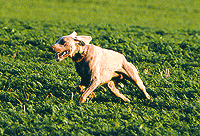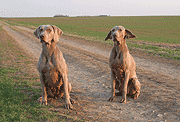|
FIELD-TRIALS in Belgium & France
The principal purpose of the fields trials is the improvement of the pure pedigree dogs. These tests make it possible to emphasize the best subjects in each race so that they can be used as well as possible in the reproduction and thus to improve the race.
The official rules and the calendar of the fields trials or other contests of work are at the disposal of each one
with the secretariat of SRSH (Société Royale Saint-Hubert, for Belgium : http://www.srsh.be ) & of S.C.C (Société Centrale Canine, for France : http://www.scc.asso.fr/ )
Only the dogs with Pedigrees and registered with the Book of the Origins of its country are allowed to take part.
The differents Working tests :
A The Spring & Summer fields trials :
These very selective contests proceed on Natural Game (gray partridges) Non Shutted in large cereal plains.
The spring field trials take place during March and April , in Belgium and in the North of France. Vegetation being
very close-cropped, at that time, and the game very being wary, the dog must develop great means to be able to
point the birds.
The summer field trials take place during July and August, on natural partridges and pheasants (or small cocks of the heathers for the contests in the mountain). The dog must also develop all its know-how to manage to block the birds.
B The Autumn fields trials :
Closer to practical hunting, these contests proceed a little everywhere in France and Belgium till September to December.
In France ( Special of Race, Interclubs or Open field trials ) & in Belgium ( only Beginners field trials ) : these tests take place on breeding game. It is called Gibier Tiré (Shooted Game) or Practical Hunting .
Open Field Trials in Belgium, take place exclusively on Natural Game (non shooted) : partridge, pheasants, woodcocks. In France certain contests take place on natural game (woodcocks or snipes). These contests are very selective and have the same value as the spring or summer field trials.
In this type of field trials, the dog must show its passion in the research of game, a cross search known as of hunting (extent on the sides but to range of rifle in front of the driver), its qualities of nose and its intelligence for hunting, its aptitude for training and the retreiving.
What is the difference between Amateurs & Open field trials :
The Amateurs field trials ( for Beginners) (in Belgium) : these contests are addressed to all the amateurs, to stockbreeders and to owners, whose young dogs or dogs are not yet classified or of which the classification them still allow them to continue in this type of test. These contests make it possible to the amateurs to be formed and to be devoted to the practice of this demanding sport. The rules are more flexible than in Open field trials.
- the notes go from the CQN to the CAC. The classifications authorized to competite in this type of contest go from the CQN to the Exc, results obtained only in Amateurs fields trials. A dog having obtained a CAC in Amateur contest will have from now on to go in Open fields trials.
- In the same way, a dog having obtained a note Exc or RCAC or CAC in Open fields trials will see itself prohibiting the Amateurs contests.
The Interclubs / Specials for Races (in France) : are addressed to all the amateurs & professionnal trainers eager to present their dogs, race of the organizing club and clubs invited for the Interclubs fields trials and reserved for a specific race in the event of Special of Race. These contests make it possible to the amateurs to be formed and to be
devoted to the practice of this demanding sport, while having fun and benefitting from cordial environment that a club can offer. In the same way, the professionals come to present young dogs. The rules are in general more flexible than in Open fields trials. The notes go from the CQN to the CAC.
The Open fields trials with CAC en/of CACIT : are addressed to all, professional and to "skilled" amateurs, of various countries. The rules are strict. The least fault is sanctioned. These contests are very selective and are opened with all the
races of the same category (the Continental ones or British). It is very difficult to be classified in this kind of tests. Only,
a small 10% of the dogs are able to be classified and even less to be classified regularly.
The notes go from the CQN to the CAC and / or CACIT.
The possible classifications :
According to the work of the dog, the judge can classify you in the following way :
The first four dogs are classified by order and qualifications and the following simply by qualifications.
Possible qualifications : Excellent - Very Good - Good - Rather Good and Insufficient, CQN and MTHR.
If your dog obtains 1st Excellent, it means the 1st place of its contest, it can be prized with a CACT (Certificate of Aptitude for the Championship of Work) if its course is exceptional. In certain fields trials, the first dog of each contest meet for a final turn to designate the best dog of the day. This last can obtain the C.A.C.I.T (Certificate of Aptitude for the International Championship of Work).
The possible Titles of Champions :
in Belgium : To become Champion of Work, it will be necessary that your dog (Male or Female) obtains in Open Field Trial to all continental pointers (Belgian tests obviously) :
- either 2 CACT of which at least 1 in Practical Hunting (it means in Open field trials in Autumn),
- or 3 CACT in Open field trials Spring.
To obtain this title of champion of work, the dog, old of fifteen months minimum, must also have obtained a minimum qualification VERY GOOD in show of beauty (see the standard of race). This title is recorded to the SRSH and will be reproduced on the pedigrees of its descent.
in France : To become Champion of Work either in Spring or in Autumn , it will be necessary that your dog obtains in this discipline (French tests only ): 4 CACT in solo for a male or 3 CACT in solo for a female.
for Spring fields trials : One of these rewards can be obtained in Club or Interclub or in summer exclusively on Natural Game.
For Autumn fields trials : One of these rewards can be obtained in Club or Interclub. The Clubs which wish it can require a retreiving in Deep Water for the homologation of the Title of Champion of autumn Field Trial.
Or
for Spring fields trials : 3 CACT in solo et 2 Exc in couple for a male or 2 CACT in solo and 1 Exc in couple for a
female. One of these rewards can be obtained in Club or Interclub or in summer exclusively on Natural Game
For Autumn fields trials : 3 CACT in solo and 1 CAC in couple for a male or 2 CACT in solo and 1 Exc in couple for a
female. One of these rewards can be obtained in Club or Interclub. The Clubs which wish it can require a retreiving in Deep Water for the homologation of the Title of Champion of autumn Field Trial.
This title is recorded with the Central Canine of your country by a diploma and will be reproduced on the pedigrees of its descent.
Note: To obtain this title of champion of work, the dog must also have obtained a minimum qualifier VERY GOOD in show of beauty (see the standard of race)
in France : To become Champion of Work "4 cases" : You have to obtain :
in Solo : 1 CACT in Spring + 1 CACT in Autumn
in Couple : 1 CACT in Spring + 1 CACT in Autumn
+ Retreiving in Deep Water
+ TB in Show of Beauty + Hip Radio A or B
Notice 1: One of the CACT can be obtained in Club or Summer on natural game.
Notice 2: One of the CACT can be obtained in Open Contest and having been used for the homologation of the title of Champion of Spring or Autumn could be taken into account for the title of Champion of Work. When the title is homologated the dogs, Champions of Spring or Autumn, will have obligatorily to run in couple.
To become International Champion of Work : a dog must have obtained :
1) At any age, 2 CACIT gained in 2 different countries under two jurys different in international fields trials sponsored by the FCI. The RCACIT will be valid if the CACIT is granted to a dog already International Champion.
2) At the minimum fifteen months age, in an international exhibition of Beauty sponsored by the FCI, at least the Very Good qualification. |

